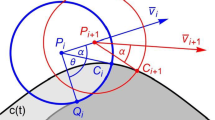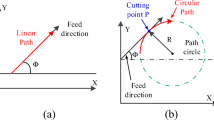Abstract
Although the conventional contour parallel tool path obtained from geometric information has been successful in making desirable shapes, it seldom considers the physical process concerns like cutting forces and chatters. In this paper, an optimized contour parallel path, which maintains constant MRR (material removal rates) at all times, is introduced and the results are verified. The optimized tool path is based on a conventional contour parallel tool path. Additional tool path segments are appended to the basic tool path in order to achieve constant cutting forces and to avoid chatter vibrations in the entire machining area. The algorithm has been implemented for two dimensional contiguous end milling operations with flat end mills, and cutting tests were conducted to verify the significance of the proposed method.
Similar content being viewed by others
References
Held M (1991) On the computational geometry of pocket machining. Springer, Berlin Heidelberg New York
Jun CS, Kim DS, Park SH (2002) A new curve-based approach to polyhedral machining. Comput Aided D 34(5):379–389
Tlusty J, Smith S, Zamudia C (1990) New NC routines for quality in milling. Ann CIRP 39(1):517–521
Kramer TR (1992) Pocket milling with tool engagement detection. J Manuf Syst 11(2):114–123
Smith S, Cheng E, Zamudia C (1991) Computer-aided generation of optimum chatter-free pockets. J Mater Process Tech 28:275–283
Iwabe H, Fujii Y, Saito K, Kisinami T (1989) Study on corner cut by end mill analysis of cutting mechanism and new cutting method at inside corner. J Jpn Soc Precis Eng 99(5):841–846
Tsai MD, Takata S, Inui M, Kimura F, Sata T (1991) Operation planning based on cutting process models. Ann CIRP 40(1):95–98
Liu Y, Zuo L, Wang C (1999) Intelligent adaptive control in milling processes. Int J Comp Integ M 12:453–460
Kim SC, Chung SC (1999) Robust cutting force control using indirect force and disturbance estimation in the end milling process. P ASPE 20:248–251
Yang MY, Lee TM (2002) Hybrid adaptive control based on the characteristics of CNC end milling. Int J Mach Tools Manu 42:489–499
Author information
Authors and Affiliations
Corresponding author
Rights and permissions
About this article
Cite this article
Kim, HC., Lee, SG. & Yang, MY. An optimized contour parallel tool path for 2D milling with flat endmill. Int J Adv Manuf Technol 31, 567–573 (2006). https://doi.org/10.1007/s00170-005-0228-1
Received:
Accepted:
Published:
Issue Date:
DOI: https://doi.org/10.1007/s00170-005-0228-1




